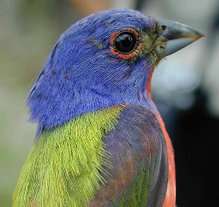Passerina
The genus Passerina is a group of birds in the cardinal family (Cardinalidae). Although not directly related to buntings in the family Emberizidae, they are sometimes known as the North American buntings (the North American Emberizidae are colloquially called "sparrows" although they are also not closely related to these birds).
| Passerina | |
|---|---|
 | |
| Painted bunting (Passerina ciris) | |
| Scientific classification | |
| Kingdom: | Animalia |
| Phylum: | Chordata |
| Class: | Aves |
| Order: | Passeriformes |
| Family: | Cardinalidae |
| Genus: | Passerina Vieillot, 1816 |
| Species | |
|
See text | |
| Synonyms | |
|
Guiraca | |
The males show vivid colors in the breeding season; the plumage of females and immature birds is duller. These birds go through two molts in a year; the males are generally less colorful in winter. They have short tails and short slim legs. They have smaller bills than other Cardinalidae; they mainly eat seeds in winter and insects in summer.
The blue grosbeak (P. caerulea) was once placed in the monotypic genus, Guiraca.
Species
The genus contains 7 species:[1]
- Blue grosbeak, Passerina caerulea (Linnaeus, 1758)
- Indigo bunting, Passerina cyanea (Linnaeus, 1766)
- Lazuli bunting, Passerina amoena (Say, 1822)
- Varied bunting, Passerina versicolor (Bonaparte, 1838)
- Painted bunting, Passerina ciris (Linnaeus, 1758)
- Rose-bellied bunting, Passerina rositae (Lawrence, 1874)
- Orange-breasted bunting, Passerina leclancherii Lafresnaye, 1840
References
- Gill, Frank; Donsker, David, eds. (2019). "Cardinals, grosbeaks and (tanager) allies". World Bird List Version 9.2. International Ornithologists' Union. Retrieved 22 June 2019.